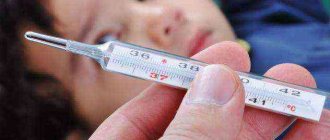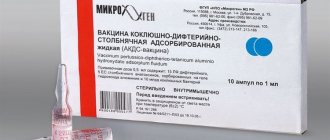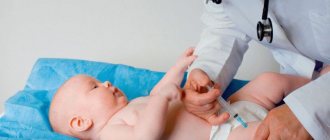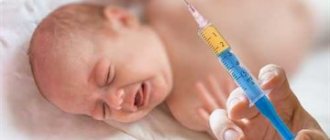Today, medicine gives parents the right to choose: to vaccinate or not to vaccinate their child. Fortunately, the majority are in favor of vaccination, but choose imported vaccines. The degree of tolerability depends on how well the child is prepared for vaccination. It is important to follow all doctor’s recommendations regarding the post-injection period.
Before you get vaccinated
Taking into account the fact that in the vast majority of cases, vaccinations are well tolerated by healthy children without any preparation or pre-treatment, the most important point in preparing a child for vaccination is to determine contraindications to vaccinations, that is, those cases of illness in a child in which vaccination can give serious adverse reactions. Contraindications and precautions for vaccination; in some cases, vaccination in children is either strictly prohibited or should be postponed to a later date. In order to correctly assess contraindications and precautions for vaccination in a child, it is important to follow the vaccination calendar and know in advance which vaccination should be given to the child and when. Before vaccinating your child and on the day of vaccination, read what contraindications and precautions are associated with the administration of a particular vaccination and make sure that the child does not have any contraindications for the vaccination. If you find it difficult to determine certain contraindications or precautions (for example, how dangerous a child’s cold or cough is), show it to your doctor. You should not blindly refuse vaccination because of a slight runny nose or cough - this will only disrupt the vaccination plan.
After what vaccinations can a child be bathed?
There are injections, after which there are no prohibitions regarding bathing the child. These are vaccinations against the following diseases:
- polio;
- rabies;
- flu;
- BCG;
- Pneumococcus;
- yellow fever;
- rubella;
- tetanus;
- whooping cough;
- measles;
- DPT;
- viral hepatitis B;
- hemophilus influenzae;
- mumps;
- diphtheria;
- cholera.
You can’t wet Manta - everyone knows this from school. This doesn't mean you shouldn't wash your hands - just don't get the injection site wet. Sweat is also a liquid, so try to avoid making your child sweat a lot. If the Mantoux sample gets wet, it may increase too much, exceeding the permissible norm (read about the Mantoux test).
After a BCG vaccination, a purulent pimple may appear. This is a normal response of the body to this vaccine, so if you notice such a pimple, do not worry. You can bathe your child after this vaccination.
After a DTP injection, slight swelling, swelling or redness of the skin may appear. There is nothing wrong with this either - such a reaction occurs quite often. You can apply a warm water compress to the area to help the swelling go away faster.
From the forums:
When can you bathe a child after DTP vaccination if there is no fever?
- Yes, at least right away
- only on the day of vaccination you can’t, the next day you can
- The next day you can definitely
Is it possible to bathe a child after polio vaccination?
—Only on the day of vaccination you can’t, if you gave an injection, if droplets then you can
“It’s just important not to steam the injection site, that’s why they say you shouldn’t bathe.” But! If the child tolerates vaccinations normally, then the next day it’s definitely possible
— You definitely shouldn’t bathe on the first day, but you can take a COLD shower for a while. if there is no temperature, she feels normal, it means she tolerates it well. even if the temperature rises slightly for a short time, it’s not scary. but for the sake of your own peace of mind, you can limit yourself to rinsing on the second day)
Is it possible to bathe a child after vaccination against measles, rubella, mumps?
- if there is no temperature, then you can
Treatment of fever and prevention of allergies after vaccination
An increase in temperature is a normal reaction of the child’s body to a vaccination, which means that the immune system has responded to the vaccine and is beginning to develop immunity (however, the absence of an increased temperature after vaccination does not mean that the vaccination was ineffective). In the case of completely healthy children, the temperature should not be lowered after vaccination if it does not exceed 38.5C. In cases of a more significant increase in temperature, and also when the temperature remains at 38.5 C in the evening, the child should be given an antipyretic. To treat fever after vaccination, it is recommended to use Paracetamol. Aspirin should never be used as an antipyretic in children.
Is it possible to wet the Prevenar vaccine?
Vaccination with Prevenar helps develop the necessary immunity in the human body against pneumococcal bacteria to prevent the development of pneumonia. This respiratory disease affects both adults and children.
However, if pneumonia affects an infant or newborn, it can often be fatal. Prevenar was considered an optional vaccination, since it was provided for a fee in clinics.
Starting from 2021, anti-pneumococcal vaccination is included in the list of mandatory preventive vaccinations.
The vaccine is not intended for everyone and according to the instructions it is administered:
- infants under two years of age;
- premature babies;
- children under 5 years of age suffering from frequent illnesses;
- infants with allergies;
- children with chronic diseases: diabetes mellitus, HIV, cirrhosis of the liver, pathologies of the respiratory tract, cardiovascular system.
Once a child reaches 5 years of age, vaccinations are not given. Prevenar is not indicated for adults and pregnant and nursing mothers. The vaccine is administered only intramuscularly: for children over 2 years old in the shoulder, and for infants under 2 years old – in the thigh. In this case, the vaccination schedule may be different - it is prescribed by the attending physician.
Like any other vaccinations, Prevenar can cause some reactions in the child’s body:
- temperature increase;
- pain and weakness in the limbs;
- local or general allergic reaction;
- nervousness, irritability, tearfulness;
- enlargement of the lymphatic system and nodes;
- impaired appetite, vomiting;
- redness and thickening at the injection site;
- convulsions, anaphylactic shock.
The active substance of the injection can be administered together with other vaccinations.
As a rule, the vaccine is easily tolerated if you follow your doctor's recommendations.
This is why the child is not allowed to bathe on the first day after immunization. Of course, no one has canceled personal hygiene, and you can wash the child, but it is not advisable to get the injection site wet. Otherwise, the side effects described above may occur.
Treatment of redness and swelling at the injection site
Most vaccinations result in more or less severe redness or swelling at the injection site. The most severe local reaction to vaccination is observed in the case of DTP (redness, swelling and pain at the injection site) and BCG (formation of a long-lasting non-healing ulcer). For all types of vaccinations, it is recommended to avoid any local treatment for redness or swelling at the injection site. If the child scratches the injection site, it can be covered with a light gauze bandage. At the site of the DTP, a compaction often forms, located deep in the muscle - a “bump”. Often such a lump is painful, and the child easily limps on one leg (if the vaccine was injected into the thigh). The formation of a dense “bump” after DPT is considered a normal reaction and does not require any treatment. Within a few weeks, the lump will resolve on its own.
What not to do after vaccination with Pentaxim: time restrictions
There are a number of prohibitions that are important to observe:
- You should not visit public places for several days before and after vaccination. This is necessary to ensure that the child does not catch the virus and get sick, since excess stress on the immune system can lead to negative health consequences;
- You should not take vitamin D for 5 days after immunization (and 3-4 days before it). This is due to the fact that it participates in calcium metabolism, on which the severity of any allergic reactions in the body directly depends;
- antihistamines, if necessary, should be prescribed by a doctor. However, after vaccination, experts do not advise giving preference to Tavegil and Suprastin, since taking them dries out the mucous membranes. Suitable, for example, are Zyrtec or Fenistil, which do not have such an effect;
- Under no circumstances should you offer your child new foods and dishes, as this may provoke a severe allergic reaction against the background of recent immunization;
- It is not recommended to treat the injection site or make compresses. Swelling, redness, tenderness and slight swelling are completely normal.
Parents often ask: is it possible to give their child antibacterial drugs if they have recently been vaccinated? We answer: such medications are prescribed only in certain cases and strictly by a doctor. This means that the child is sick and will not be able to recover without antibiotics.
Recent immunization is not a contraindication to taking antibacterial drugs. They also cannot influence the effectiveness of vaccination.
Why can't you go for a walk after vaccination?
> Health >
25.10.2019
Timely vaccination provides protection against many pathologies that can negatively affect health. This is especially true in childhood. Therefore, many parents have a number of questions related to vaccination of children. Basically, they are perplexed why they can’t go for a walk after vaccinations, although doctors do not have a consensus on this matter.
What happens in the body after the vaccine is administered
The purpose of vaccination is to increase the immune status of the body. It contains strains of the virus that, penetrating into the systemic bloodstream, provoke the development of a mild form of the disease. The body's fight against antibodies helps prevent viral infection in the future.
Sometimes a child’s health worsens for several days after the vaccine is administered. He loses his appetite, nausea occurs, and in some cases the temperature rises abruptly. This significantly increases the risk of the penetration of infectious pathogens, which is why it is recommended not to visit crowded places and postpone walking outside.
Why you can’t walk outside on the day of vaccination
The ban on walking on the day of vaccination is explained by the risk of complications and adverse reactions. But not all doctors are unanimous in this opinion, as the popular TV presenter and pediatrician Komarovsky claims that walks in the fresh air in summer and winter will improve the child’s well-being.
Another opinion of doctors is that after passive immunization, the body intensively produces immunity, and during this period it is most vulnerable. Therefore, vaccinated children should stay home for the next 3 days.
It is important to know! Do not confuse the physiological reaction to vaccination with the development of complications. The latter are observed in rare cases and are accompanied by a sharp rise in temperature up to 40 degrees, loss of consciousness, the appearance of convulsions and rashes throughout the body.
What rules are important to follow after vaccination?
After immunization vaccinations, special attention should be paid to the general well-being and appearance of the child. During this period, it is necessary to periodically take temperature measurements. It can rise to low-grade levels (37.5 degrees), which is not a pathology. In addition, it is recommended to observe the following rules:
- For 2 days, it is best to reduce the amount of food you eat. It should have a liquid consistency and be neutral in taste.
- Eliminate allergenic foods from your diet (citrus fruits, chocolate, egg yolk).
- If a child is prescribed vitamin D, it should be stopped 2 days before vaccination. It is allowed to resume the course of treatment 5 days after vaccination.
- On the day of vaccination, water procedures are prohibited.
- If there is a need to go outside, you need to choose clothes so that the child does not sweat. You should avoid appearing in public places for 3 days.
- Limit communication with peers.
Is it possible to wet the injection site and when is it permissible to bathe a child?
Many parents have a reasonable question about why water procedures after vaccination are prohibited. This should not be done for the following reasons:
- while bathing, the child may become hypothermic, which increases the risk of developing colds, which is extremely undesirable during immunization;
- pathogenic microflora can penetrate through the wound at the injection site, which will cause the development of complications;
- in some cases, bathing can cause an abrupt increase in body temperature.
Based on this, water procedures can be used after two days from the date of vaccination. The child’s well-being is taken into account. As for infants, bathing can be replaced by wiping with a damp cloth, but this avoids exposure to the injection site.
How much and when should you refrain from walking outside?
After the vaccine is administered, the body temporarily rearranges its functioning. The reaction to the vaccine lasts from 3 to 72 hours. During this period of time, walking in the fresh air is extremely undesirable. If you feel well, they can be resumed in a day. To avoid the development of negative reactions, doctors recommend taking a break for 3 days.
In the summer, it is best to walk in the fresh air in the morning or evening. In winter, lunchtime is suitable for this. In autumn and spring the weather becomes rainy and windy. This can cause the development of negative local reactions, and therefore for the first 3 days after immunization there is a taboo on walking outside.
There are a number of restrictions that do not allow walking in the fresh air:
- if after vaccination the body temperature exceeds 37.5 ° C;
- when the baby’s poor health is accompanied by fatigue and lack of desire to play;
- decreased appetite and feeling of nausea;
- if the lymph nodes are enlarged or the child experiences coldness in the extremities;
- when compaction and redness appear at the injection site.
When and for how long do restrictions on walking and swimming apply after vaccination?
Each type of vaccination affects the child's body differently. In this regard, there is a difference in limiting walks on the street and in carrying out water procedures.
What restrictions are there on walking and swimming after passive immunization?
Table 1: Types of medications and description of restrictions on walking and swimming
| Number in order | Type of grafting | Brief description of restrictions |
| 1 | DTP (vaccine against whooping cough, diphtheria and tetanus) | For the first three days, children’s bodies intensively fight against the virus. Going outside is associated with exposure to additional infection. This may cause complications. Therefore, practitioners do not recommend taking walks in the fresh air for a period of 3 days. During this period of time, you should not wet the injection site. Since the likelihood of infectious pathogens entering through the wound increases. |
| 2 | For hepatitis | If vaccination is performed separately from other types of vaccination, this does not affect the baby’s usual daily routine. On the same day you are allowed to walk outside and carry out water treatments. The situation is different if vaccination is combined with DTP vaccination. In this case, the restriction on walking and swimming is 2-3 days. |
| 3 | From polio | Administration of inactivated polio serum usually does not cause adverse reactions. If you are feeling well, your child can be taken outside on the day of vaccination. Lack of temperature does not prohibit taking a bath. But if possible, you should reduce the time of contact with water. When immunized simultaneously with DPT vaccination, restrictions on walking and swimming extend for 2 or 3 days. |
| 4 | For rubella, mumps and measles | The vaccination is well tolerated by children, and therefore if the weather is good outside, daily walks cannot be canceled. Only in this case should you not visit the playground, limiting communication with peers. Swimming is allowed on the same day, but the vaccination site should not be rubbed with a washcloth. Parents are warned that the possibility of complications may occur after 2 weeks. |
| 5 | For the flu | The period for the development of possible complications lasts for 72 hours. Although your child is allowed to go for walks, he should avoid active physical play. The flu shot does not exclude the possibility of taking a shower or bath, but for children it is best to postpone water procedures for 2 days. They can be replaced by wiping with a damp towel. |
| 6 | BCG (against tuberculosis) | Vaccination is carried out in the maternity hospital, provided that the child is healthy. If the vaccination was carried out after discharge from the maternity hospital, then the possibility of performing water procedures is permitted after 2 days from the date of vaccination. In terms of walks, pediatricians do not have a consensus. Some argue that fresh air will help strengthen the immune system. Others object, noting that being outside increases the chance of contracting colds. Therefore, before going outside, you need to assess the child’s well-being. |
| 7 | Mantoux (test for the presence of Mycobacterium tuberculosis) | Practitioners do not recommend giving up daily walks after performing the mantoux test. The exception is those cases when the child appears unwell, and general weakness occurs against the background of a temperature jump. In order for the sample to have reliable readings, the wound site should not be wetted, combed or covered with a band-aid. |
| 8 | Diaskintest test for the presence of Koch bacilli (tuberculosis) | A modern technique that allows you to determine the presence of tuberculosis, even when it is not clinically manifested. Walking in the fresh air is not a limitation after this manipulation. But at the same time, you should not overcool the forearm area (where the sample was taken). In order not to reduce the information content of the test, it is forbidden to wet your hand and swim during the day. |
| 9 | Pentaxim | This is an improved analogue of the DTP vaccine, but unlike it, the vaccine is much easier to tolerate, although the likelihood of side effects cannot be ruled out. Most often they occur during revaccinations. After administering this serum, it is best to protect the child from hypothermia, which is why it is not recommended to bathe him or go outside for the next 2-3 days. |
| 10 | Prevenar (for pneumonia) | Vaccination reduces the likelihood of penetration and growth of pneumococcal infection. After completing it, it is not prohibited to take walks on the street, but you should avoid crowded places. During rainy, windy or frosty weather, going outside should be postponed. It is prohibited to wash the child or wet the injection site for 24 hours (from the moment of vaccination). |
Parents independently decide whether to vaccinate their child. But we should not forget that they can prevent the development of many serious pathologies. At the same time, the risk of complications is 1% of all vaccination cases.
Watch the video on the topic:
Why can't you go for a walk after vaccination? Link to main publication
Source: https://pochemunet.ru/zdorovje/pochemu-nelzya-gulyat-posle-privivki
Why doctors recommend not to go for walks - supporters and opponents
In fact, walking with your child after DTP vaccination is possible and even necessary. Why do doctors say that you can’t walk for three days? There are a number of reasons for this:
- After vaccination, the child’s immune system produces antibodies for three days and may not be able to cope with external viruses and bacteria on the street. As a result, the baby will get sick.
- Mothers ignore the rules and try to dress their baby warmer for a walk, provoking sweating. This leads to irritation of the vaccination site, and complications such as slight swelling and redness are possible.
- Overwrapping leads to an increase in body temperature. The child is inside numerous layers of clothing, as if in a steam room. This provokes complications after DTP in the form of high fever.
- You should not go outside with your child during hot or rainy seasons, when an increase in body temperature and contact of the vaccine with wet clothing is more likely.
DTP and polio at the same time - is it possible to do it?
You can walk outside with your child when the weather is good: the temperature in the sun is not higher than 20 degrees, the humidity is not more than 40%. In the rain and frost after vaccination, you should refrain from going outside. Mandatory conditions for walks will be that the baby is in good health and when there is no elevated temperature. If the thermometer shows 37.1, this is a signal to parents that it is better not to go outside.
When the baby has a fever on the first day after vaccination, and the condition returns to normal on the second day, we recommend that you refrain from going outside. Keep the baby at home for another 1 day and if no complications arise, you can go for a walk. In cases of complications, we recommend not to walk with the baby for 3 days.
Parents of children will ask, why not attend clubs or kindergarten? It is better to avoid places where children gather; they begin to visit them 3 days after vaccination. Children communicate closely and any bacteria spread faster in a group. A vaccinated child is vulnerable for three days and can easily become infected with any disease. Since the vaccine is effective, the immune system is busy producing antibodies. It will be difficult to fight the most harmless disease.
Actions of parents after vaccination with DPT or Pentaxim
The DTP vaccine is a vaccination against three serious diseases: whooping cough, tetanus and diphtheria. It is this that causes a huge amount of controversy, since it is considered the most reactive. Vaccination is often quite difficult for children to tolerate: the temperature rises, up to 39 degrees, allergic reactions, leg pain and other side effects often occur.
In public clinics, free of charge, the child is given a separate DPT vaccination and is given drops against polio separately. The imported vaccine Pentaxim is designed to protect babies from five diseases at once. These include whooping cough, tetanus, polio, diphtheria and diseases caused by the bacteria Haemophilus influenzae type b. They cause pneumonia and meningitis.
READ IN DETAIL: What infections does the Pentaxim vaccine protect against?
Regardless of the type of injection given, doctors strongly recommend that you follow all of their instructions immediately after vaccination. Especially when it comes to walking and water treatments.
Why can't you go for a walk on the day of vaccination?
From time immemorial, there has been an opinion that it is not recommended to go for a walk after any vaccination. Doctors have different opinions on this matter. Thus, Dr. Komarovsky strongly recommends going out into the fresh air both in summer and winter. Let's consider several points of view on this matter.
Pediatricians say that you can and should go for a walk, but as an insurance policy, it is better to refrain from walking for the first three days after vaccination. At this time, it is better not to go anywhere, to protect your child from communicating with peers.
After vaccination, the body is busy developing immunity against the diseases inoculated into it. There is no need for extra workload and unwanted contacts now. Neglecting these rules can result in a more serious illness. It will not be the vaccine that is to blame, but the mother.
For some time after vaccination with Pentaxim, you cannot attend kindergarten and clubs. In a large group, viruses spread faster, which means a vaccinated baby is much more vulnerable than his friends. If the DTP went without complications, then on the third day you can send the child to a preschool institution.
READ ALSO: Is it possible to walk with a child at elevated temperatures?
Walking schedule for a child after DTP
The day after vaccination requires complete abstinence from walking. It is quite possible that a baby, including a newborn, will not have a reaction to the vaccine at all. The ban on walking is due to the fact that a vaccinated child needs to be observed a little. If there is no fever or other side effects, you can go for a walk the next day.
A walk after DTP is carried out in compliance with a special routine:
READ ALSO: what are the consequences of the DTP vaccine?
- Exit in favorable weather: in summer no more than +20 degrees with air humidity 40% or less, in winter up to -10, provided that there is no strong wind outside.
- You can walk for no more than an hour the day after vaccination. The child should not have a fever. Some pediatricians allow the possibility of going out into the fresh air with newborns if the temperature does not rise above 37.5 degrees.
- There is no need to wrap the child up. The baby may sweat, which will negatively affect the injection site. It may become red, slightly swollen and cause discomfort. In addition, there is a risk of artificially raising the baby’s temperature.
- Walks should be calm, with a minimum amount of outdoor games. It is important to avoid playgrounds and refuse to visit shopping centers: all this can provoke unwanted reactions in a newly vaccinated body. It’s also better not to visit at this time.
READ ALSO: what to do if a month-old baby's temperature is 37 degrees?
The “weather” in the house is also important. Some time after vaccination, it is necessary to observe the baby, his appetite and mood. The temperature in the rooms should not exceed 22 degrees. It will be good to humidify the air as much as possible. When a child does not want to eat, there is no need to force him. It is better to give more water, compote, fruit juice or other drinks.
Thus, you should not go for a walk immediately after DTP vaccination. It is optimal to go outside after a few days, when the child’s body has recovered and can repel harmful bacteria and viruses as much as possible.
READ ALSO: how is DPT revaccination carried out?
Is it possible to wet the injection site and after how many days is it allowed to bathe the child?
The rules for swimming are quite simple:
- you should not swim on the day of vaccination, as there is a high risk of fever,
- on the second day, if there are no complaints, the child can be washed.
You should not get the injection site wet for 24 hours after the injection. In this regard, any water procedures are contraindicated. If the child is still very young, it is enough to wipe him with wet wipes, avoiding the wound area. You can give your child a full bath already on the second day, provided the baby is feeling well and has no fever.
READ ALSO: How to properly bathe a newborn baby at home for the first time?
In general, the ban on swimming after vaccination is associated with a careful attitude towards the health of your child. While swimming, it is easy to become hypothermic and get sick, which is extremely undesirable. Here is the answer to the question: “why is it not advisable to bathe a vaccinated person in the first 24 hours?”
Vaccinated against polio: when is it time to take a bath and go outside?
Vaccination against polio is carried out with inactivated polio serum (IPV).
The percentage of typical vaccination reactions for modern drugs is minimal. When immunized against polio by the oral route, the temperature rises extremely rarely. If there is no deterioration in health or fever, you can go for a walk with your child even on the day of vaccination. Brief washing with warm water is not prohibited.
Reactions to the polio drug occur more often when polio vaccine is administered simultaneously with DTP. If a child has received both vaccinations at once, he should refrain from walking and swimming for 2-3 days.
When should a child not go outside after vaccination?
The child must be monitored; any deviations in his behavior may indicate a complication after the vaccination. The walk must be postponed in the following cases:
- the temperature has risen, the thermometer shows more than 37.5 °C;
- the baby is capricious, does not play, gets tired quickly;
- no appetite;
- extremities are cold;
- enlarged lymph nodes;
- there is swelling, redness or rashes on the area of the body where the vaccine was administered.
After DTP vaccination
For 3 days after the vaccine is administered, all the baby’s defenses are aimed at fighting the new strain of the virus, so they may not be able to cope with an additional infection picked up by the child during a walk. After vaccination, most mothers have an irresistible desire to wrap up their child and put as much warm clothing on him as possible. This does not protect it from bacteria and viruses.
He overheats, sweats, and his temperature rises. This after DTP vaccination can cause complications.
In summer, in warm, windless weather, walking in deserted places is not dangerous. Comfortable air temperature for walking is 20-22 °C. In frost, wind, and rain, it is better to refrain from visiting the street. After DTP, you should not walk for 3 days, even with a slight increase in body temperature.
For hepatitis
If the child is healthy, then vaccination against hepatitis should not lead to a sharp increase in temperature. The child’s good health on the day of hepatitis vaccination allows him to go for walks as usual. There are also no restrictions on swimming.
From polio
The introduction of polio vaccine into the body is not accompanied by an increase in temperature. After vaccination against polio, a child can be taken out for walks without fear from the first day.
How long after a child is allowed to walk and bathe after vaccination with Pentaxim?
Pentaxim is an imported vaccine against whooping cough, diphtheria and tetanus, which is accompanied by fewer side effects (we recommend reading: differences between the Pentaxim and Infanrix Hexa vaccinations). In most children, the temperature rises within 24 hours after the injection and gradually decreases over a period of 3 to 72 hours.
As with other serums of this group, it is not advisable to bathe the child and walk with him during the first two days after vaccination. The baby needs to be given the most gentle treatment possible to protect him from infection with viruses and bacteria.
In children who tolerate other vaccinations well, fever and other side effects after Pentaxim are not excluded. Due to the gradual accumulation of antibodies to serum components in the body, children react most acutely to the fourth revaccination.
If the temperature remains within normal limits within 24 hours after the injection, the next day an hour-long walk in the fresh air is allowed, provided the weather is good and you feel normal. If necessary, you can bathe the child. It is not prohibited to wet the injection site itself - contact with water does not pose a threat.
Is it allowed to bathe a baby and walk outside after hepatitis vaccination?
The child receives the first vaccination against hepatitis while still in the maternity hospital. The baby is injected with exactly as many weakened viruses as the body can overcome. This is how immunity to hepatitis disease is developed. Revaccination is carried out when the baby is 1 month old.
There are usually no side effects from the hepatitis vaccine, but since every child is different, you should follow the rules of behavior after the hepatitis vaccine.
The child’s body may react differently to the introduction of weakened bacilli: weakness may appear, a low temperature may rise, and the baby will be lethargic and drowsy. Of course, in this case it is better to refuse walks. You should also not bathe on the first day after the vaccine is administered.
Some pediatricians say that in the absence of any signs of illness in the baby, you can bathe and wet the injection site. On the first day, it is better to do this in the shower, and do not rub the wound with a washcloth. After bathing the child, dry with a towel and lightly blot the injection site.
Despite the fact that hepatitis vaccination is quite easily tolerated and gives a reaction in rare cases, children should start walking on the second or third day after vaccination. It is better to avoid places with large crowds of people (playgrounds, shopping centers). Attendance at clubs and sections must be limited for a time.
READ ALSO: hepatitis vaccine at 1 month: side effects
Walking and swimming are strictly prohibited if:
- the child has a fever, lymph nodes are enlarged,
- rashes appear on the skin, severe itching bothers you,
- The baby complains of nausea.
Is it possible to bathe a child and walk with him after a polio vaccination?
Normally, the polio vaccine does not cause a reaction. If it was done separately, then there are no restrictions on visiting the street and swimming. The baby feels well, the temperature is normal - you can safely go outside.
READ ALSO: What are the side effects of the polio vaccine?
In public clinics, it is customary to simultaneously administer the polio vaccine in combination with severe DTP. In this case, a negative reaction may appear specifically to the latest vaccine. The same applies to the case when the baby receives Pentaxim, which includes a complex of 5 weakened bacteria.
READ ALSO: How do children tolerate the Pentaxim DTP vaccine?
Video on the topic
About the Pentaxim vaccination in the video:
The multicomponent vaccine Pentaxim is designed to protect the child’s body from 5 different serious diseases. If medical instructions are correctly followed before and after vaccination, the vast majority of children do not have any negative manifestations.
A rise in temperature, rashes, and other negative reactions to vaccination occur due to the individual characteristics of a particular child and if recommendations are not followed during preparation for vaccination. But they also pass quickly and without a trace.
The child receives immunity from deadly, intractable diseases that can lie in wait for him everywhere. Therefore, parents who care about the health of their baby should definitely get this vaccination to provide him with reliable immunity.
Interests: proper and healthy nutrition, treatment and prevention of diseases in children from birth to 18 years. He considers raising healthy children to be the most important point, therefore he pays great attention to hardening and preventive methods.
Author of books and articles on children's health, education and development, as well as on the treatment and prevention of diseases in adult patients. Author of “Modern Collection of Medicines” and other books on medical and pharmaceutical topics. Collaborates with medical journals and publishing houses.
Young mothers are perplexed why they can’t walk outside with their child after vaccination if the baby is cheerful and doesn’t feel sick. Doctors have differing opinions on this issue. Some people categorically prohibit walking, others believe that fresh air helps the child recover faster after vaccination.











